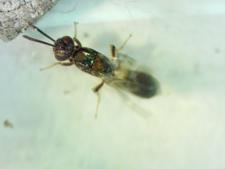Francesc Gómez Marco, Ph.D.
Postdoctoral Scholar
Phone: (951) 827-4360
francegm@ucr.edu
Dr. Gómez Marco joined the Hoddle laboratory as a Postdoctoral Researcher in June 2019. His previous research experience was on biological control programs and insect ecology on citrus pests principally. He has been working on the Proactive Biological Control Program for the Spotted Lanternfly (Lycorma delicatula) which has been sponsored by the Californian Department of Agriculture. The main objective of this project is to develop a biological control program with the parasitoid of the spotted lanternfly Anastatus orientalis and to test the non-target hosts of this parasitoid species on the West coast of USA.
Dr. Gómez Marco is an advocate for the implementation of Biological Control programs. As an applied entomologist, his research had focused on classical and conservation biological control programs and on the ecology and behavior of natural enemies which can enhance integrated pest management programs in different agroecosystems.
Current Projects
Spotted Lanternfly
Spotted lanternfly (SLF) Lycorma delicatula (Hemiptera: Fulgoridae) is host of over 70 plant species. SLF is spreading rapidly on the East coast of the USA and it is a significant invasion threat to California. This fulgorid is an emerging pest of vine and tree crops and woody ornamental trees and it has caused extreme damage on grapevines crops in Pennsylvania.
Curriculum vitae
Degrees
- Ph.D. Agricultural Resources and Technologies, Department of Plant Production, Universitat Politecnica de Valencia, and Valencian Institute for Agricultural Research, Spain (2015)
- M.Sc. Certificate in Education, Universitat Politecnica de Valencia, Spain (2006)
- B.Sc. Biology, Faculty of Biology, Universitat de Valencia, Spain (2005)
Publications
- Gómez-Marco, F., Yoshimoto, A., Braswell, W. E., & Stouthamer, R. (2020). Evaluation of δ15N analysis to trace the origin of Diaphorina citri (Hemiptera: Liviidae) to citrus orchard fertilization management. PeerJ, 8, e8807.
- Gómez-Marco, F., Gebiola, M., Stouthamer, R., Simmons, G. 2019. Impact of the temperature in the phenology of Diaphorina citri (Hemiptera: Liviidae) and on the establishment of Tamarixia radiata (Hymenoptera: Eulophidae) in urban areas in the lower Colorado desert in Arizona. Environmental Entomology. https://doi.org/10.1093/ee/nvz048
- Gebiola, M., Gómez-Marco, F., Simmons, G., Stouthamer, R. 2018. Effect of host feeding on life traits of Tamarixia radiata (Hymenoptera: Eulophidae), parasitoid of the Asian citrus psyllid. BioControl. https://doi.org/10.1007/s10526-018-9903-7
- Gómez-Marco, F., Urbaneja, A., Tena, A. 2016. A sown grass cover enriched with wild forb plants improves the biological control of aphids in citrus. Basic and Applied Ecology 17: 210-219.
- Gómez-Marco, F., Tena, A., Jacas, J.A., Urbaneja, A. 2015. Early arrival of predators control Aphis spiraecola (Hemiptera: Aphididae) colonies in citrus clementine. Journal of Pest Science 89: 69-79.
- Gómez-Marco, F., Urbaneja, A., Jaques, J.A., Rugman-Jones, P., Stouthamer, R., Tena, A. 2015. Untangling the aphid-parasitoid food web in citrus: Can hyperparasitoids disrupt biological control? Biological Control 81: 111-121.
- Manuel Porcar, Francesc Gómez, Axel Gruppe, Antonio Gómez-Pajuelo, Inmaculada Segura, Roland Schröder. 2008. Hymenopteran specificity of Bacillus thuringiensis strain PS86Q3. Biological Control 45: 427-432.
Outreach Publications
- Gómez-Marco, F. August 2016. Integrated Pes Management of Aphis spiraecola (Hemiptera: Aphididae) in clementines: enhancing its biological control. Ecosistemas 25(2): 114-118
- Gómez-Marco, F., Jaques, J.A., Urbaneja, A., Tena, A. 2015. El hiperparasitismo dificulta el control biológico de Aphis spiraecola en clementinos. Levante Agrícola. pp 4.
- Gómez-Marco, F., Hermoso de Mendoza, A., Tena, A., Jacas, J.A., Urbaneja, A. October 2012. Mejora del control biológico de pulgones mediante la gestión de cubiertas vegetales. Vida Rural. pp 7.

